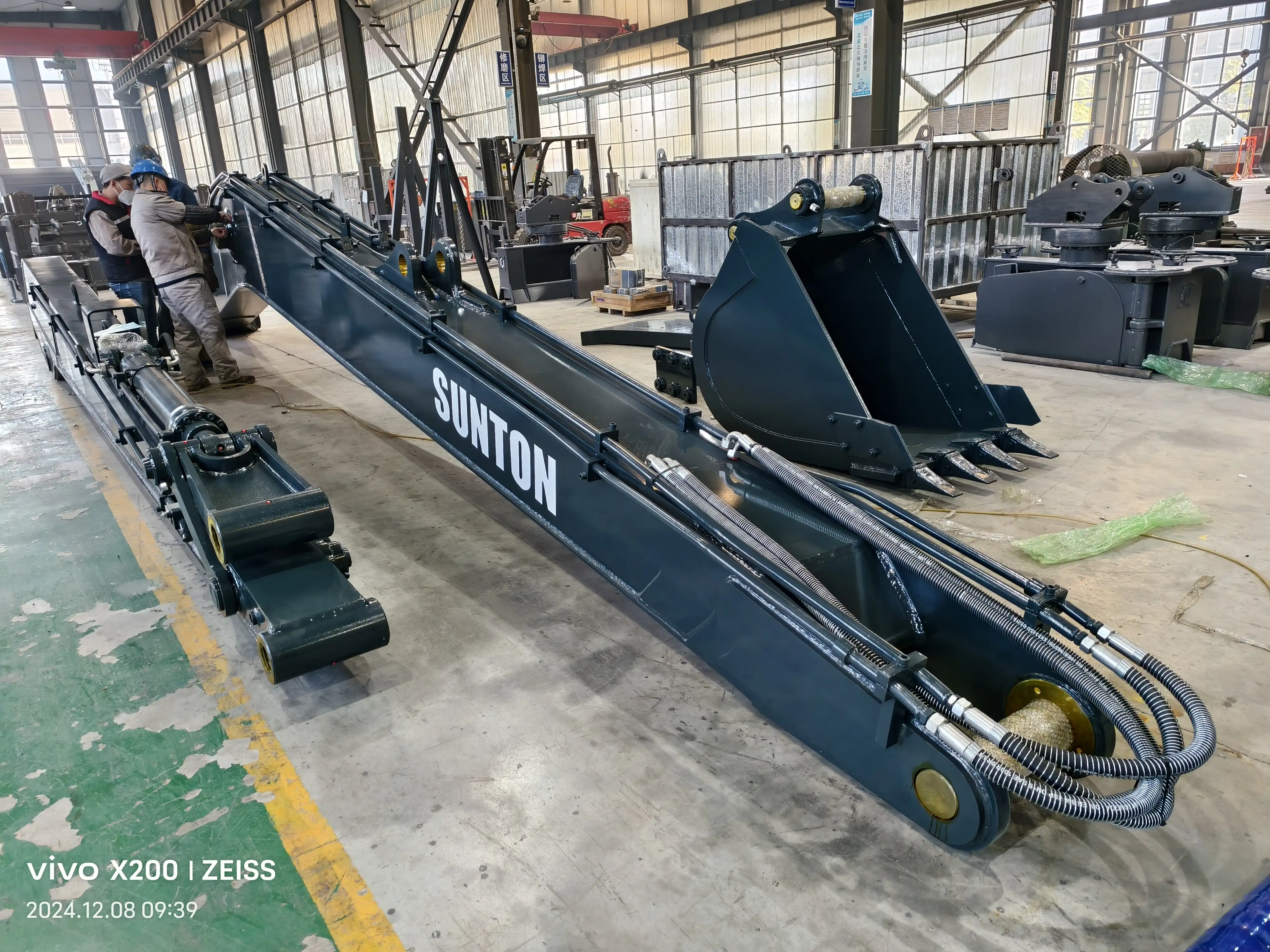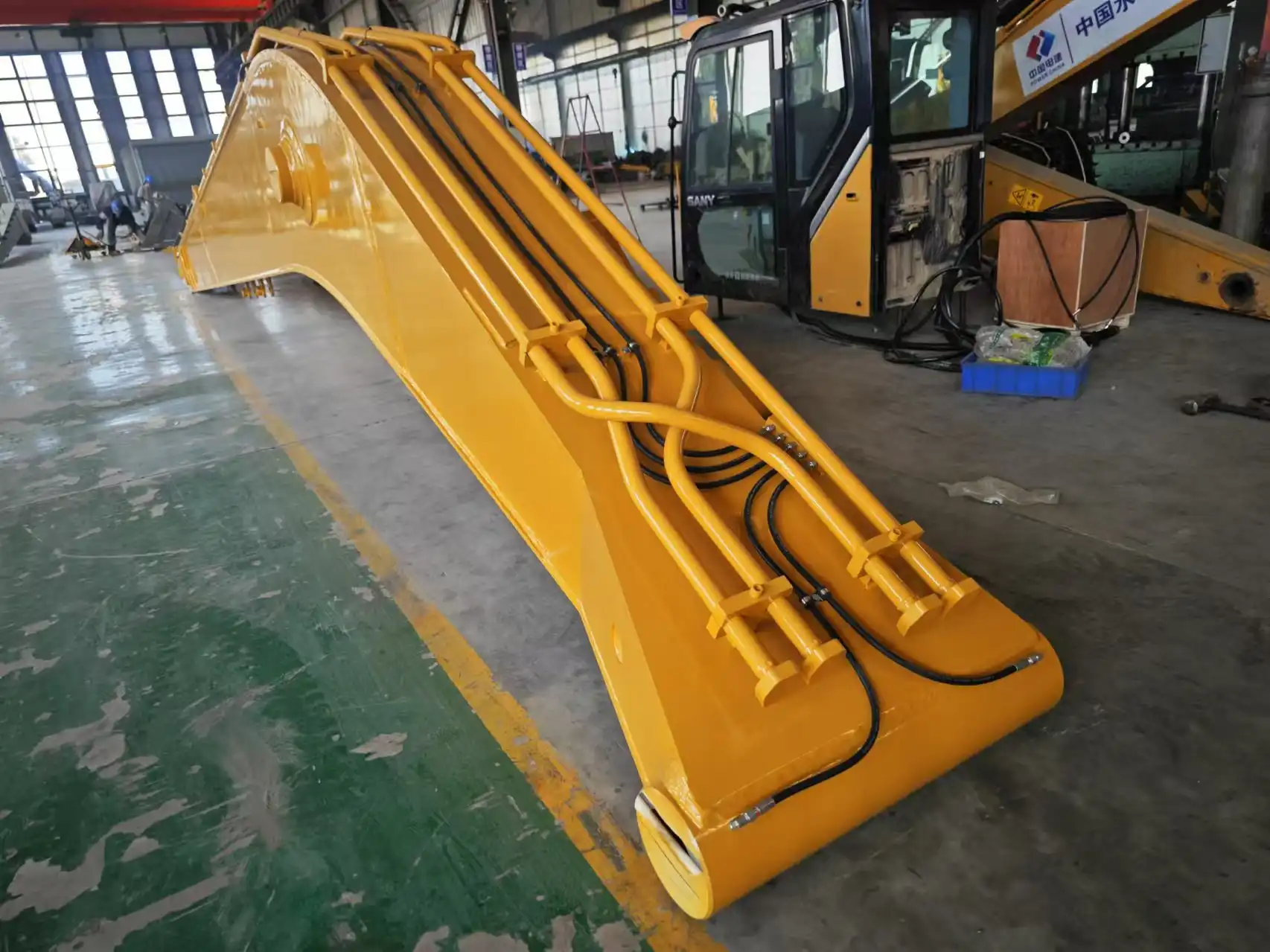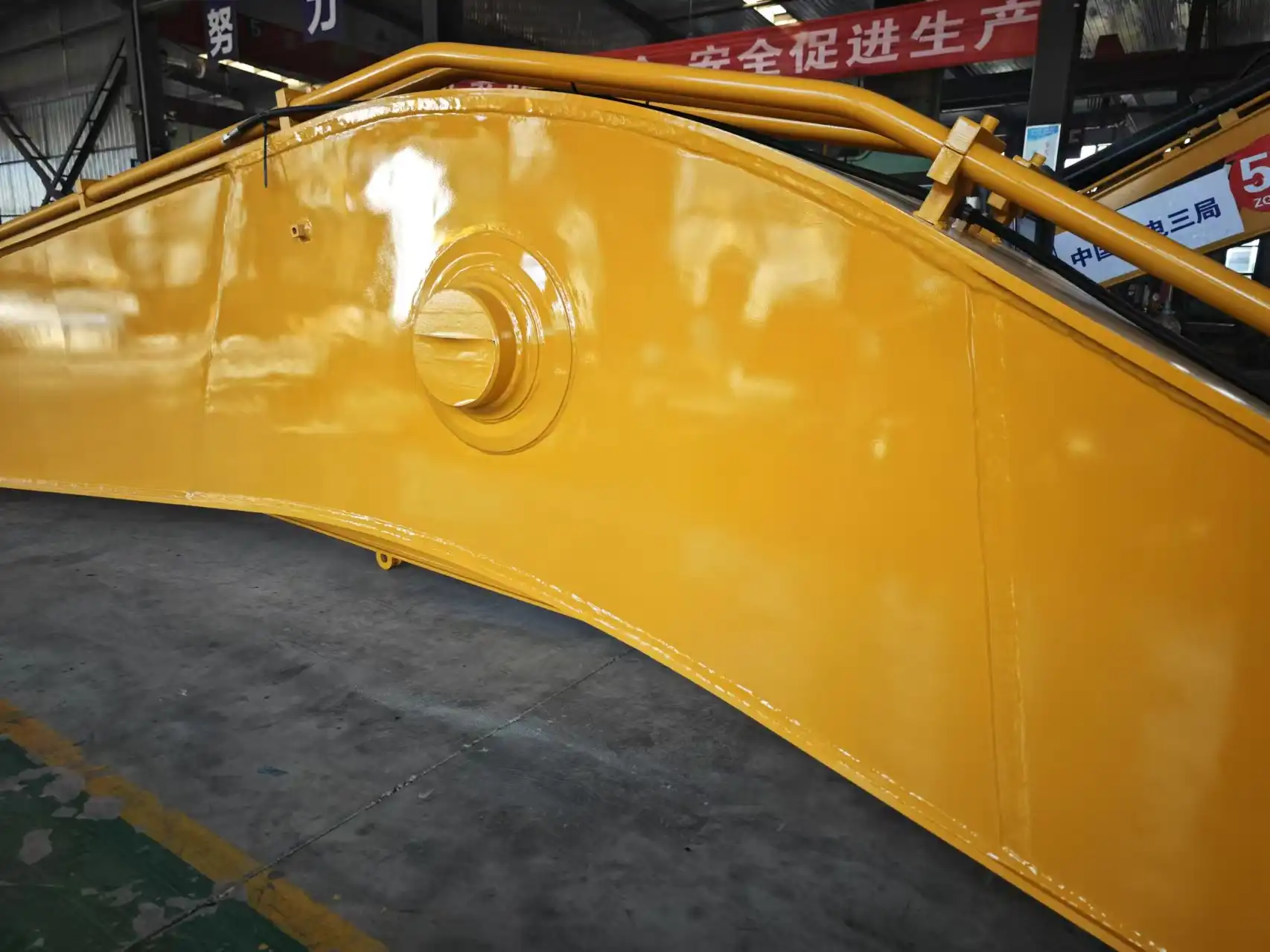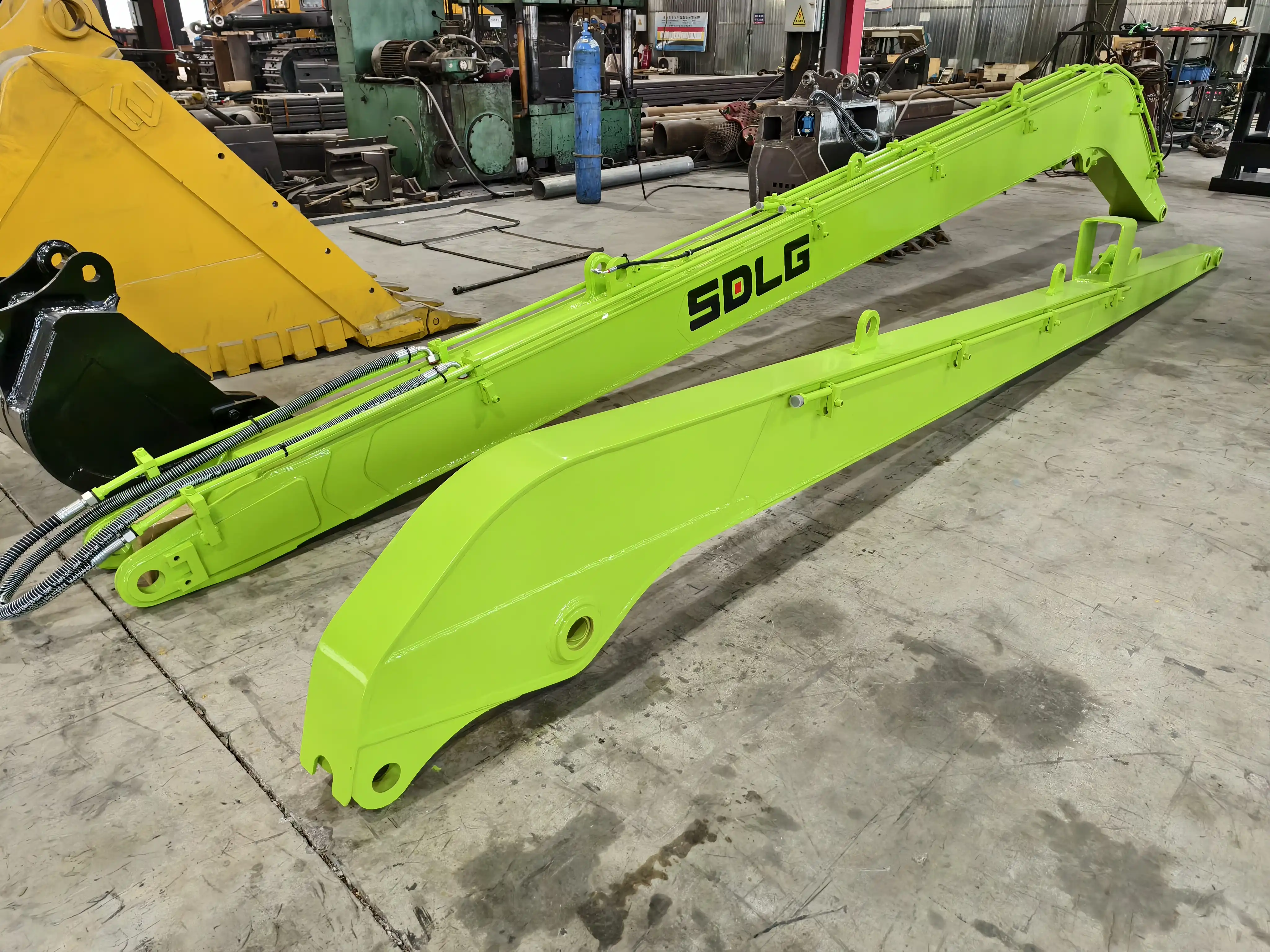What is the length of a long reach excavator arm?
The length of a long arm excavator typically ranges from 15 meters to 30 meters, depending on the specific model and application requirements. At Tiannuo Machinery, our standard long arm models feature arm lengths of 16,000mm to 18,000mm (16-18 meters), providing maximum reach capabilities between 15,300mm and 17,300mm. This extended reach allows operators to access areas that would be impossible with conventional excavators, making them invaluable for specialized applications like river dredging, deep trenching, and slope maintenance. The design balances reach capabilities with stability considerations, as longer arms require counterweights and structural reinforcements to maintain operational safety and efficiency. With proper configuration, these specialized machines can achieve impressive digging depths of 11,200mm to 12,200mm and maximum excavation heights ranging from 13,500mm to 15,300mm, offering versatility across diverse project requirements.
Main Boom

The Foundation of Reach Capability
The main boom serves as the primary structural component of any long arm excavator, establishing the fundamental working parameters for the entire machine. In the design of excavator arms, the main boom bears considerable importance as it must withstand significant stress during operation while maintaining precise control. Standard main booms for long reach configurations typically measure between 12 to 20 meters in length, providing the essential foundation for extended reach capabilities.
The engineering behind these substantial components involves careful consideration of material selection and structural design. High-strength alloy steel, often with enhanced carbon content, provides the necessary durability while remaining relatively lightweight. This balance is crucial because every additional kilogram in the boom structure requires corresponding counterweight adjustments to maintain machine stability.
Trapezoidal Cross-Section Engineering
What sets advanced long reach excavator booms apart is their trapezoidal cross-section design. Unlike conventional rectangular or cylindrical profiles, the trapezoidal shape delivers superior torsional rigidity, the ability to resist twisting forces that occur during digging operations. This enhanced rigidity translates directly to improved precision in excavation work, allowing operators to maintain control even at maximum extension.
The trapezoidal profile achieves this through geometric optimization, distributing stress more effectively across the boom structure. When examining professional-grade excavator booms, you'll notice reinforcement plates strategically positioned at high-stress junction points. These reinforcements prevent material fatigue and extend the operational lifespan of the equipment, particularly important when working with the extreme leverages created by extended reach configurations.
Hydraulic Integration and Performance
Modern main booms incorporate sophisticated hydraulic systems designed specifically for long-reach applications. These systems regulate oil flow rates and pressures to compensate for the increased distances, ensuring responsive control regardless of arm position. The hydraulic cylinders mounted on the main boom typically feature larger diameters than standard excavator models, providing the necessary force multiplication to handle heavy loads at extended reaches.
Engineers must carefully balance the hydraulic power with boom flexibility. While rigidity is essential for accuracy, a completely inflexible boom would transfer excessive shock loads to the machine's undercarriage during operation. The ideal design incorporates controlled flexibility, enough to absorb operational shocks while maintaining precise positioning capabilities that operators depend on for delicate work like underwater excavation or slope grading.
Extension Arm

Engineering for Extended Reach
The extension arm represents a critical component in the overall reach system of a long arm excavator. This secondary segment connects directly to the main boom through a robust pin shaft connection, effectively extending the machine's operational radius. Unlike conventional excavator designs, specialized long reach models utilize extension arms measuring between 5 to 8 meters for single-section configurations, though multi-section variants can achieve even greater extensions.
The engineering challenges associated with extension arm design are substantial. As the connection point between the main boom and the working implement, this component must maintain structural integrity while facilitating smooth articulation. Manufacturing typically involves precision-welded high-tensile steel plates with internal reinforcing structures. These reinforcements prevent deflection under load, a crucial consideration when operating at maximum extension where even minor flexing can dramatically affect precision.
Pin Shaft Connection Mechanics
The pin shaft connection between the main boom and extension arm warrants particular attention in long reach arm excavator design. This critical junction must permit fluid rotational movement while handling tremendous shear forces during operation. Engineers employ oversized hardened steel pins with bronze bushings to minimize friction and wear at these pivotal connection points.
Advanced designs incorporate greasing channels that allow maintenance personnel to lubricate these joints without disassembly, extending operational life and reducing downtime. The pin diameter itself often exceeds 100mm on larger models, providing the necessary surface area to distribute operational stresses effectively. Some manufacturers utilize eccentric mounting arrangements that permit field adjustments to compensate for natural wear over the equipment's lifespan.
Hydraulic Synchronization Systems
Extension arms incorporate sophisticated hydraulic synchronization systems that coordinate movement between multiple boom sections. These systems utilize proportional valves and pressure compensators to ensure smooth, controlled operation regardless of load conditions. In practical terms, this means operators can maintain precise control when performing delicate tasks like underwater pipeline placement or environmental remediation work.
The hydraulic cylinders controlling extension arm movement typically incorporate end-cushioning features that prevent shock loading at the limits of travel. This cushioning protects both the structural components and the operator from jarring impacts when reaching full extension or retraction. Progressive manufacturers also incorporate position sensors that feed data to the machine's control systems, enabling features like programmable depth limits and automated movement sequences that enhance both safety and productivity in challenging applications.
Stick:

Terminal Component Functionality
The stick functions as the terminal component of the long arm excavator's articulation system, serving as the direct connection point for work implements like buckets, grapples, or specialized attachments. This crucial element typically measures between 3 to 6 meters in length, with the specific dimension carefully calculated to complement the overall reach capabilities of the machine. Unlike standard excavator sticks, those designed for long reach applications incorporate additional reinforcements to handle the increased leverage forces encountered during extended operations.
Material composition for excavator sticks requires particular attention, with manufacturers employing high-tensile steel alloys with yield strengths exceeding 600 MPa. These advanced materials allow for thinner profiles without sacrificing structural integrity, reducing overall weight while maintaining performance parameters. The cross-sectional design often incorporates internal webbing structures that provide maximum strength along primary force vectors while minimizing material usage in non-critical areas.
Angular Positioning and Force Transmission
The efficiency of any long arm excavator depends significantly on the stick's angular positioning relative to both the extension arm and the work surface. This angle directly affects the transmission of hydraulic power into effective digging force. Optimal force transmission occurs when the stick maintains approximately a 90-degree angle to the resistance force, though practical operations often require working at less ideal angles.
Manufacturers address this challenge through carefully engineered hydraulic cylinder placement, providing maximum force application throughout the working range. The cylindrical attachment points feature reinforced mounting brackets with multi-directional gusseting to handle the substantial forces generated during operation. Advanced designs incorporate variable pressure control systems that automatically adjust hydraulic output based on stick position, maintaining consistent performance regardless of extension configuration.
Implement Integration Considerations
The stick terminates at the quick coupler or direct attachment point, where various implements connect to the long arm excavator. This interface requires particularly robust design elements to accommodate the diverse loading conditions encountered during operation. Quick-change systems have become industry standard, allowing operators to switch between specialized attachments without leaving the cab, dramatically improving operational efficiency.
The stick's end connection point typically incorporates hardened wear plates and replaceable bushings to address the inevitable wear from constant attachment changes. Hydraulic lines running to the attachment point must accommodate the full range of stick movement without restriction or potential damage, requiring careful routing and protection systems. Many advanced designs incorporate integrated tool control systems with programmable flow and pressure settings for various attachments, allowing operators to optimize performance for specific tasks without manual adjustments to the hydraulic system.
FAQ

①What determines the maximum length of a long arm excavator?
The maximum length of a long arm excavator is determined by several factors including the base machine's weight and stability, hydraulic system capabilities, and intended application requirements. Larger base machines can support longer arms due to their increased counterweight capacity and structural integrity. Most manufacturers limit maximum lengths to around 30 meters for practical operation, as longer configurations require specialized transportation solutions and face diminishing returns in terms of operational efficiency.
②How does arm length affect stability in excavators?
Arm length directly impacts excavator stability by altering the machine's center of gravity during operation. Longer arms create greater leverage forces that must be counterbalanced to prevent tipping. Manufacturers compensate by adding counterweights, widening tracks or outriggers, and implementing advanced hydraulic management systems that limit operational parameters based on arm position and load weight. Operators must remain mindful of stability boundaries, particularly when working at maximum extension.
③What maintenance considerations are unique to long reach excavator arms?
Long reach excavator arms require specialized maintenance protocols focused on structural integrity verification and hydraulic system optimization. Key maintenance points include regular inspection of pin joints for wear and proper lubrication, hydraulic cylinder seal inspection to prevent drift under extended load conditions, and stress crack detection along primary load-bearing surfaces. Hydraulic systems typically require more frequent fluid analysis to detect contamination before it damages precision components operating under increased pressure requirements.
Long reach excavator arms represent sophisticated engineering solutions for specialized excavation challenges, balancing reach capabilities with structural integrity and operational efficiency. Whether your project involves river dredging, slope maintenance, or other applications requiring extended reach, understanding the components and capabilities of these specialized machines is essential for optimal equipment selection and utilization. For more information about Tiannuo Machinery's range of long arm excavators and customization options tailored to your specific project requirements, please contact us at rich@stnd-machinery.com.
References
Journal of Construction Engineering and Machinery, "Advancements in Long Reach Excavator Design for Environmental Applications," Volume 42, Issue 3, 2023.
International Standards Organization, "Safety Requirements for Extended Reach Excavation Equipment," ISO 19296:2018.
Engineering Digest, "Hydraulic System Design Considerations for Long Reach Excavators," Technical Review Series, 2022.
Construction Equipment Manufacturer's Association, "Best Practices Guide for Long Arm Excavator Operation and Maintenance," 3rd Edition, 2024.
American Society of Mechanical Engineers, "Structural Analysis of Extended Boom Configurations in Heavy Excavation Equipment," ASME Journal of Mechanical Design, Volume 145, 2023.
About Author: Arm
Arm is a leading expert in the field of specialized construction and railway maintenance equipment, working at Tiannuo Company.

